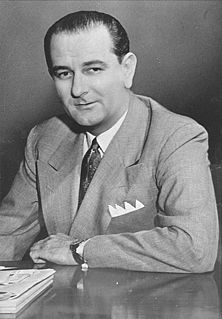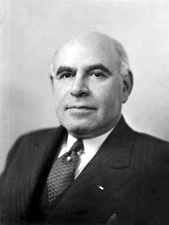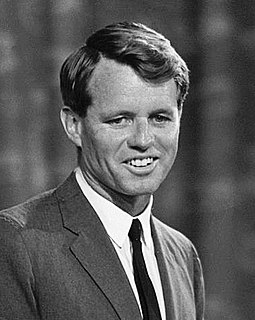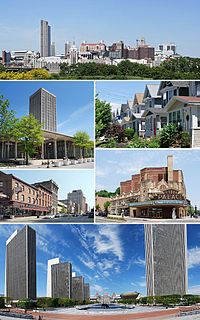
The 1964 United States Senate elections coincided with the election of President Lyndon B. Johnson by an overwhelming majority, to a full term. His Democratic Party picked up a net two seats from the Republicans. As of 2019, this is the last time either party has had a two-thirds majority in the Senate, which would have hypothetically allowed the Senate Democrats to override a veto, convict and expel certain officials, or invoke cloture without any votes from Republicans. The Senate election coincided with Democratic gains in the House in the same year.

The 1956 United States Senate elections were elections for the United States Senate that coincided with the re-election of President Dwight D. Eisenhower. Although the Democrats gained two seats in regular elections, the Republicans gained back two seats in special elections, leaving the party balance of the chamber remained unchanged.

The 1950 United States Senate elections occurred in the middle of Harry S. Truman's second term as President. As with most 20th-century second-term mid-terms, the party out of the Presidency made significant gains. The Republican opposition made a net gain of five seats, taking advantage of the Democratic administration's declining popularity during the Cold War and the aftermath of the Recession of 1949. The Democrats held a narrow 49 to 47 seat majority after the election. This became the first time since 1932 that the Senate Majority Leader lost his seat and the only instance where the majority leader lost his seat while his party retained the majority.

The 1948 United States Senate elections were elections which coincided with the election of Democratic President Harry S. Truman for a full term. Truman had campaigned against an "obstructionist" Congress that had blocked many of his initiatives, and in addition the U.S. economy recovered from the postwar recession of 1946–47 by election day. Thus Truman was rewarded with a Democratic gain of nine seats in the Senate, enough to give them control of the chamber.

The 1946 United States Senate elections were held November 5, 1946, in the middle of Democratic President Harry S. Truman's first term.

The United States Senate elections of 1938 occurred in the middle of Franklin D. Roosevelt's second term. This occurred six years after the Democratic landslide in the 1932 election, and so the opposition Republicans gained seven seats from the Democrats. However, the Democrats retained a commanding lead over the Republicans with more than two-thirds of the chamber.

Although the 17th Amendment was not passed until 1913, some states elected their Senators directly before its passage. Oregon pioneered direct election and experimented with different measures over several years until it succeeded in 1907. Soon after, Nebraska followed suit and laid the foundation for other states to adopt measures reflecting the people's will. By 1912, as many as 29 states elected senators either as nominees of their party's primary or in conjunction with a general election.

The 1958 New York state election was held on November 4, 1958, to elect the Governor, the Lieutenant Governor, the State Comptroller, the Attorney General, a judge of the New York Court of Appeals and a U.S. Senator, as well as all members of the New York State Assembly and the New York State Senate.

The 1974 New York state election was held on November 5, 1974, to elect the Governor, the Lieutenant Governor, the State Comptroller, the Attorney General, two judges of the New York Court of Appeals and a U.S. Senator, as well as all members of the New York State Assembly and the New York State Senate.

The 1966 New York state election was held on November 8, 1966, to elect the Governor, the Lieutenant Governor, the State Comptroller, the Attorney General and the Chief Judge of the New York Court of Appeals, as well as all members of the New York State Assembly and the New York State Senate. Besides, 15 delegates-at-large to the New York State Constitutional Convention of 1967 were elected on the state ticket, and three delegates each in the 57 senatorial districts.

The 1950 New York state election was held on November 7, 1950, to elect the Governor, the Lieutenant Governor, the State Comptroller, the Attorney General and a U.S. Senator, as well as all members of the New York State Assembly and the New York State Senate.

The 1938 New York state election was held on November 8, 1938, to elect the Governor, the Lieutenant Governor, the State Comptroller, the Attorney General, two U.S. Senators and two U.S Representatives-at-large, as well as all members of the New York State Assembly and the New York State Senate.

The 1934 New York state election was held on November 6, 1934, to elect the Governor, the Lieutenant Governor, the State Comptroller, the Attorney General, a U.S. Senator, two U.S. Representatives-at-large, the Chief Judge and two associate judges of the New York Court of Appeals, as well as all members of the New York State Assembly and the New York State Senate.

The 1930 New York state election was held on November 4, 1930, to elect the Governor, the Lieutenant Governor, the State Comptroller, the Attorney General and a judge of the New York Court of Appeals, as well as all members of the New York State Assembly and the New York State Senate.

The 1928 New York state elections were held on November 6, 1928, to elect the Governor, the Lieutenant Governor, the State Comptroller, the Attorney General, a U.S. Senator and a judge of the New York Court of Appeals, as well as all members of the New York State Assembly and the New York State Senate.

The 1932 New York state election was held on November 8, 1932, to elect the Governor, the Lieutenant Governor, the State Comptroller, the Attorney General, the Chief Judge, a U.S. Senator and two U.S. Representatives-at-large, as well as all members of the New York State Assembly and the New York State Senate.

The 1937 New York state election was held on November 2, 1937, to elect a judge of the New York Court of Appeals, as well as all members of the New York State Assembly. Besides, delegates for the New York State Constitutional Convention, to be held in 1938, were elected, and an amendment to the State Constitution which proposed the increase of the term in office of the members of the New York State Assembly to two years, and of the statewide elected state officers to four years, was accepted.

The 1940 New York state election was held on November 5, 1940, to elect three judges of the New York Court of Appeals, a U.S. Senator and two U.S Representatives-at-large, as well as all members of the New York State Assembly and the New York State Senate.

The 1944 New York state election was held on November 7, 1944, to elect a judge of the New York Court of Appeals and a U.S. senator, as well as all members of the New York State Assembly and the New York State Senate.

The 1964 United States Senate election in New York was held on November 3, 1964. Incumbent Republican U.S. Senator Kenneth Keating ran for re-election to a second term, but was defeated by Robert F. Kennedy.






















